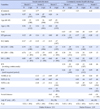Abstract
Purpose
The purpose of this study was to examine the effects of human rights sensitivity and social distance in psychiatric hospital orderlies on attitudes toward mental illness, including authoritarianism, benevolence, social restrictiveness, and community mental health ideology.
Methods
Participants were 201 psychiatric hospital orderlies working in one national mental hospital or one of 10 private mental hospitals. Data were collected from May 9 to June 22, 2016. Data were analyzed with descriptive statistics, independent t-test, one-way ANOVA, Pearson correlation coefficients and hierarchical multiple regression using the SPSS/WIN 21.0 program.
Results
Human rights sensitivity and social distance were statistically significant predictors for the attitude toward mental illness in psychiatric hospital orderlies. Hierarchical multiple regression analysis revealed that human rights sensitivity and social distance explained an additional 23% of authoritarianism, 16% of benevolence, 35% of social restrictiveness and 29% of community mental health ideology.
Figures and Tables
Table 3
Correlations between Human Right Sensitivity, Social Distance and Attitude toward the Mental Illness (N=201)

References
1. The National Mental Health Commission, National Center for Mental Health. 2015 national mental health statistics: pilot study [internet]. Seoul: The National Mental Health Commission, National Center for Mental Health;2016. 06. cited 2016 June 30. Available from: http://www.ncmh.go.kr/snmh/data/snmhDataView.jsp?no=8084&fno=106&gubun_no=0&pg=1&search_item=0&search_content=&menu_cd=M_04_05_01_00_00.
2. OECD. Health at a Glance 2013: OECD Indicators (Korean version). Seoul: OECD/Korea Policy Centre;2014. p. 215. DOI: 10.1787/9789264215221-ko.
3. Kim TH. Over 2,500 unqualified psychiatric hospital orderlies are working at mental hospitals. Medical Today. 2007 October 29;Sect. 01. Available from: http://kamh.co.kr/bbs/board.php?bo_table=news&wr_id=978&sfl=wr_subject&stx=2500&sop=and.
4. Lee AK. A study of psychiatric technicians' attitudes toward mental illness [master's thesis]. [Seoul]: Ewha Womans University;2007. 82.
5. Lee YC, Park JY. Qualitative analysis about experience of a mental hospital psychiatric technicians during isolation and restraint work - focus on the consensual qualitative research. Ment Health Soc Work. 2015; 43(2):60–88.
6. Stewart D, Burrow H, Duckworth A, Dhillon J, Fife S, Kelly S, et al. Thematic analysis of psychiatric patients' perceptions of nursing staff. Int J Ment Health Nurs. 2015; 24(1):82–90. DOI: 10.1111/inm.12107.

7. Porsdam Mann S, Bradley VJ, Sahakian BJ. Human rightsbased approaches to mental health: a review of programs. Health Hum Rights J. 2016; 18(1):1–13. DOI: 10.17863/CAM.195.
8. National Human Rights Commission of the Republic of Korea. Mental health petition incident (2011~2015) [internet]. Seoul: National Human Rights Commission of the Republic of Korea;2016. 04. cited 2016 Apr 30. 1–9. Available from: http://www.humanrights.go.kr/search/XSearch.jsp.
9. Lee HY. A study on seclusion and restraint in psychiatric hospital. Seoul: National Human Rights Commission of the Republic of Korea;2015. 11. Research paper. Report No. 11-1620000-000587-01.
10. Huh JR, Na DS, Lee DS. The institutional improvement for invigorating human rights education in Korea: some implications from foreign cases. J Hum Rights Law Relat Educ. 2013; 6(1):171–202.
11. Kim KM. Possibility of the new education for human rights utilizing literature. Bukyong Hum Soc Sci Res. 2015; 16(3):139–162.
12. Jang JW, Lee YH. The effects of non-disabled elementary school student's emotional intelligence and human rights sensitivity on acceptance attitude of disability. J Rights Child Disabil. 2015; 6(1):1–26.
13. Moon YL, Moon MH, Gwak YJ. Developing indicators of psychological scale for human rights sensitivity. Seoul: National Human Rights Commission of Korea;2002. 12. Research paper. No. 02-45.
14. Ha YJ, Chae EH, Yang AJ. Study on human rights awareness of people with mental disorders among mental health workers. Korean J Health Serv Manag. 2013; 7(1):83–94. DOI: 10.12811/kshsm.2013.7.1.083.

15. Stuber JP, Rocha A, Christian A, Link BG. Conceptions of mental illness: attitudes of mental health professionals and the general public. Psychiatr Serv. 2014; 65(4):490–497. DOI: 10.1176/appi.ps.201300136.

16. Lee SY. The relationship between nursing students' social distance and attitudes toward the mentally disabled individuals [master's thesis]. [Daegu]: Keimyung University;2015. 61.
17. Smith AL, Cashwell CS. Social distance and mental illness: attitudes among mental health and non-mental health professionals and trainees. Prof Couns. 2011. 1(1):p. 13–20.

18. Tumasjan A, Strobel M, Welpe I. Ethical leadership evaluations after moral transgression: social distance makes the difference. J Bus Ethics. 2011; 99(4):609–622. DOI: 10.1007/s10551-010-0671-2.

19. Jeong JS, Park ME. A study on college students social distance toward people with the mental illness. J Rehabil Res. 2013; 17(2):253–277.
20. Westie FR. Negro-white status differentials and social distance. Am Sociol Rev. 1952; 17(5):550–558.

21. Taylor SM, Dear MJ. Scaling community attitudes toward the mentally ill. Schizophr Bull. 1981; 7(2):225–240.

22. Lee JH, Lee CS, Hwang TY, Han GS, Lee YM. Community attitudes toward the mental ill in Suseo-Ilwon community. Bull Yong-In Psychiatr Inst. 1996; 3(2):188–202.
23. Cho JK, Lee SY, Yoon GJ. Efficient utilization of nursing assistants and the personnel management system improvement. Seoul: Korea Institute for Health and Social Affairs;2004. Policy Research Report. Report No. 2004-64.
24. Jung SY. A study on the human rights sensitivity of professionals in the mental hospital. Ment Health Soc Work. 2006; 23:59–87.
25. Yang OK, Kim CH. Human rights and social prejudice of the mentally ill. Ewha J Soc Sci. 2004; 12:357–373.
26. Anagnostopoulos F, Hantzi A. Familiarity with and social distance from people with mental illness: testing the mediating effects of prejudiced attitudes. J Community Appl Soc Psychol. 2011; 21(5):451–460. DOI: 10.1002/casp.1082.

27. Ayazi T, Lien L, Eide A, Shadar EJ, Hauff E. Community attitudes and social distance towards the mentally ill in South Sudan: a survey from a post-conflict setting with no mental health services. Soc Psychiatry Psychiatr Epidemiol. 2014; 49(5):771–780. DOI: 10.1007/s00127-013-0775-y.

28. Jung SY, Son DS, Baek HU. The worker's attitudes toward the mentally ill people in the homeless facilities. Ment Health Soc Work. 2008; 28:67–95.
29. Chambers M, Guise V, Välimaki M, Botelho MA, Scott A, Staniuliené V, et al. Nurses' attitudes to mental illness: a comparison of a sample of nurses from five European countries. Int J Nurs Stud. 2010; 47(3):350–362. DOI: 10.1016/j.ijnurstu.2009.08.008.

30. Ju HG, Lee KJ, Kim HS. Effects of human right sensitivity program on the human right consciousness and attitudes of the mental health of psychiatric mental health nurses. J Korean Acad Psychiatr Ment Health Nurs. 2013; 22(3):169–179. DOI: 10.12934/jkpmhn.2013.22.3.169.





 PDF
PDF ePub
ePub Citation
Citation Print
Print






 XML Download
XML Download